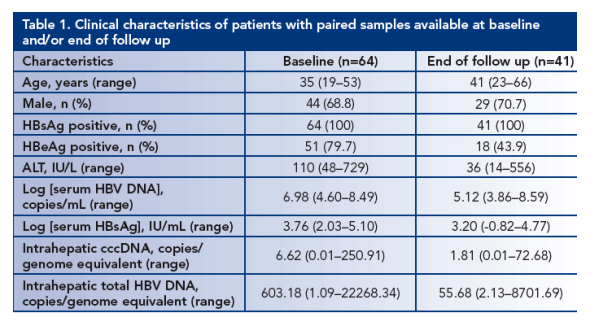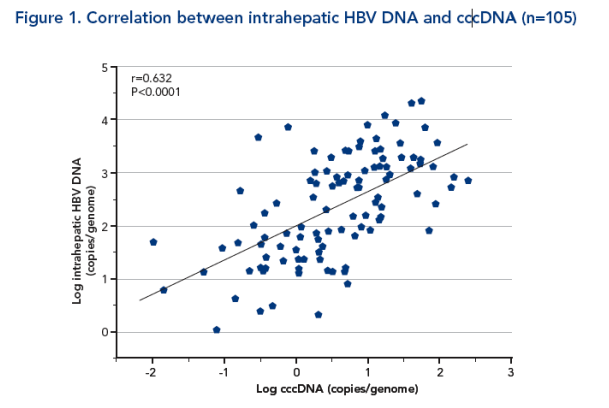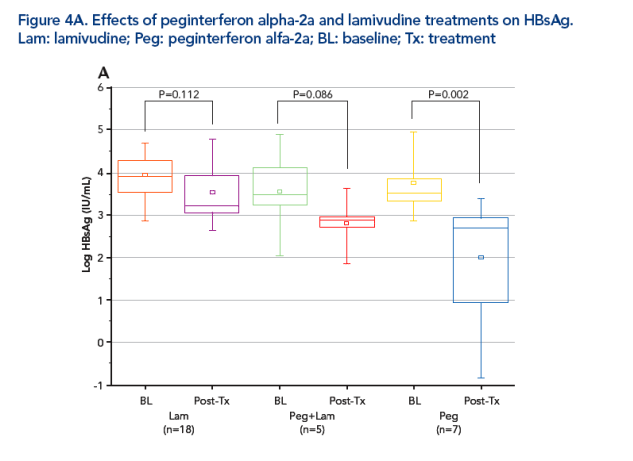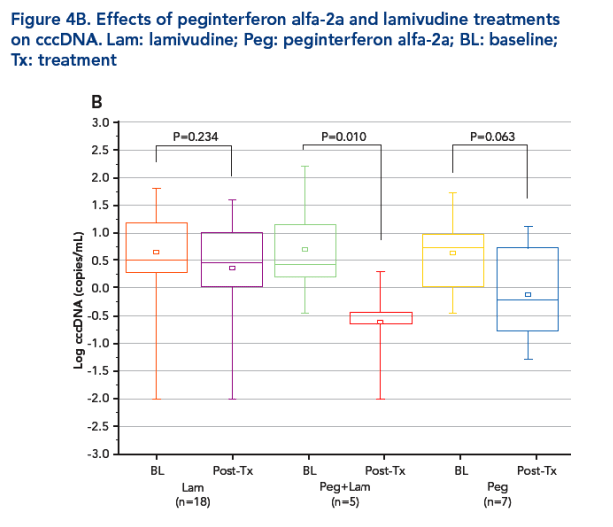 |
 |
 |
| |
Correlation Between HBV cccDNA And HBsAg Levels And Their Reduction
By Peginterferon Alfa-2a-Based Therapy In Patients With Chronic Hepatitis B
|
| |
| |
Reported by Jules Levin
59th Annual Meeting of the American Association for the Study of Liver Diseases, October 31-November 4 2008, San Francisco, USA
aL Lu,1 aD-W Ye,1 aY-D Wang,1 aAYK Kwok,1 aA Wong,1 aY-H Yueng,1 aH-Y Zhang,1 aY-C Chen,1 aS Bowden,2 bR Batrla,3 cS Locarnini,2 dGKK Lau1
1Department of Medicine, The University of Hong Kong, Hong Kong SAR, China; 2Victorian Infectious Diseases Reference Laboratory, North Melbourne, Victoria, Australia; 3Hoffmann-La Roche Ltd, Basel, Switzerland
Background
In chronic hepatitis B (CHB), intrahepatic hepatitis B virus (HBV) covalently closed circular DNA (cccDNA) acts as the transcriptional template for HBV
RNA production1
The reservoir of HBV cccDNA in the nucleus of infected cells poses a difficult hurdle for antiviral therapy to overcome and monitoring its level may provide an indication of treatment efficacy
However, measurement of HBV cccDNA requires liver tissue and it has been proposed that serum HBsAg levels may provide a non-invasive surrogate
marker of HBV cccDNA2
OBJECTIVES
To determine the relationship between cccDNA and HBsAg levels in samples from CHB patients
To observe any effects of peginterferon alfa-2a and/or lamivudine therapy on levels of cccDNA and HBsAg
Author Summary
Serum HBsAg levels showed a good correlation with cccDNA levels. A low baseline HBsAg was superior to HBV cccDNA and serum HBV DNA in predicting virologic response to peginterferon alfa-2a and lamivudine therapy. Peginterferon alfa-2a-based treatments effectively reduced HBV intrahepatic cccDNA and serum HBsAg levels compared with lamivudine
AUTHOR CONCLUSION
Serum HBsAg levels correlate well with cccDNA levels and may provide a noninvasive marker of cccDNA. Low baseline HBsAg level is better than HBV DNA and cccDNA in predicting a good response to therapy
METHODS
Liver biopsy and serum samples from 86 patients were tested for intrahepatic total HBV DNA, cccDNA, serum HBV DNA and HBsAg
A total of 19 patients had longitudinal liver biopsy samples at baseline and end of follow up. A further 45 patients had paired samples at baseline only; therefore, 64 samples were available for analysis at baseline. A total of 22 patients had paired samples available at end of follow up only and, therefore, 41 samples were available for analysis at end of follow up (Table 1)

Twelve patients received treatment with peginterferon alfa-2a ± lamivudine (seven with peginterferon alfa-2a alone and five in combination with lamivudine) and 18 patients received lamivudine monotherapy. The treatment period was 48 weeks, followed by 24 weeks of post-treatment follow up
Serum HBV DNA, intrahepatic cccDNA and total HBV DNA were measured by realtime PCR. HBsAg in serum was quantified by the Architect assay (Abbott Diagnostics)
RESULTS
Intrahepatic HBV cccDNA levels were significantly lower in HBeAg-negative CHB patients [median (range): 0.93 (0.01-14.54) copies/genome] than in HBeAg-positive patients [8.06 (0.01-250.91) copies/genome; P<0.0001]
Intrahepatic total HBV DNA was significantly correlated with viral cccDNA (r=0.632, P<0.0001, Figure 1)

There was a significant correlation between cccDNA and serum HBsAg levels (r=0.429, P<0.0001, Figure 2A). Serum HBV DNA also correlated with cccDNA (r=0.509, P<0.0001, Figure 2B)

For patients undergoing therapy, lower baseline HBsAg level (area under ROC curve: 0.769, P=0.001) was superior to HBV cccDNA (0.734, P=0.005) or serum HBV DNA (0.714, P=0.010) in predicting virologic responses (HBeAg seroconversion and HBV DNA levels undetectable by PCR) to peginterferon alfa-2a and/or lamivudine treatment (Figure 3)

There was a significant reduction in HBsAg level after treatment with peginterferon alfa-2a (P=0.002), and a strong trend towards reduction in cccDNA (P=0.063). The combination of peginterferon alfa-2a and lamivudine significantly reduced cccDNA levels (P=0.010); the HBsAg level was markedly reduced, but missed significance in the lamivudine and peginterferon alfa-2a combination (P=0.086). In contrast, lamivudine alone had little effect on either cccDNA (P=0.234) or HBsAg (P=0.112) levels (Figure 4)


REFERENCES
1. Laras A et al. Intrahepatic levels and replicative activity of covalently closed circular hepatitis B virus DNA in chronically-infected patients. Hepatology 2006;
44:694-702
2. Chan HL et al. Serum hepatitis B surface antigen quantitation can reflect hepatitis B virus in the liver and predict treatment response. Clin Gastroenterol Hepatol 2007;5:1462-8
DISCLOSURE INFORMATION
aNo conflict of interest; bRoche, employment; cGilead & Bristol-Myers Squibb,
Advisory Committees or Review Panels; dRoche & Novartis, Consulting.
Editorial support for the development of this poster was funded by
F. Hoffmann-La Roche Ltd, Basel, Switzerland
|
| |
|
 |
 |
|
|